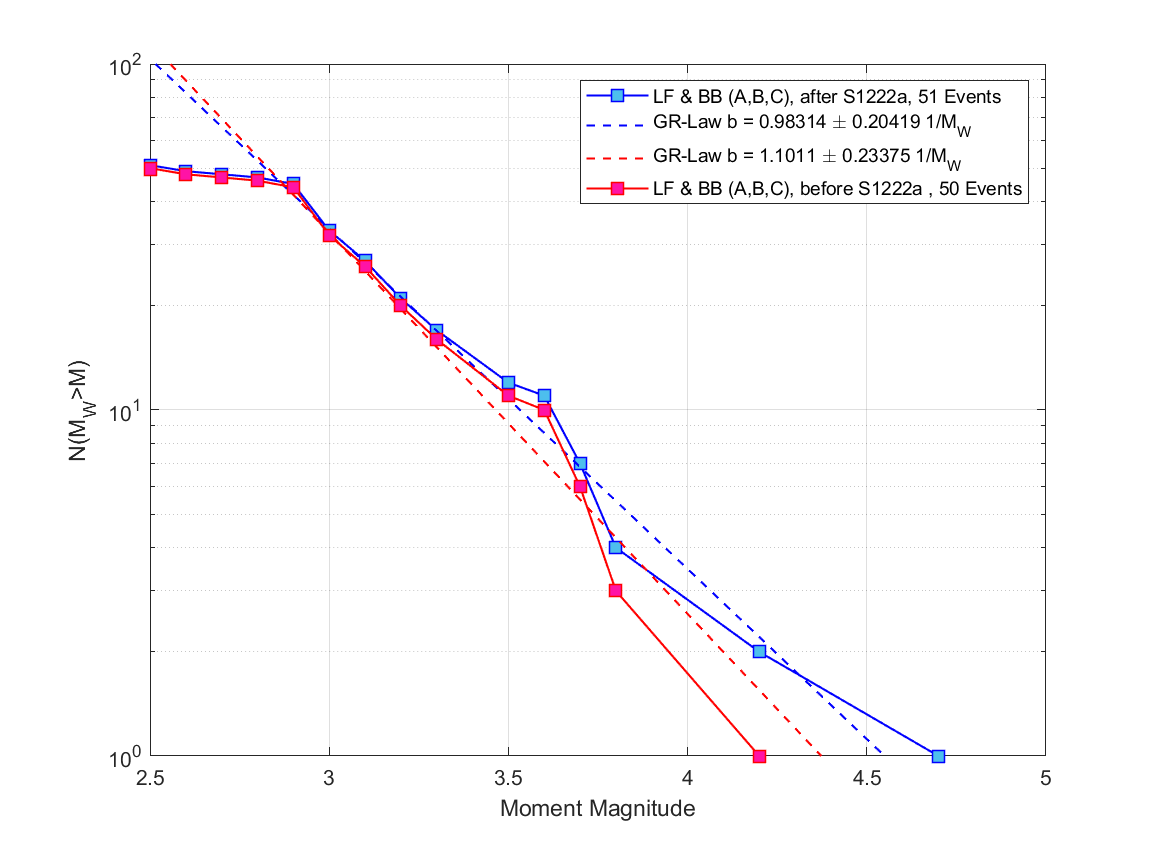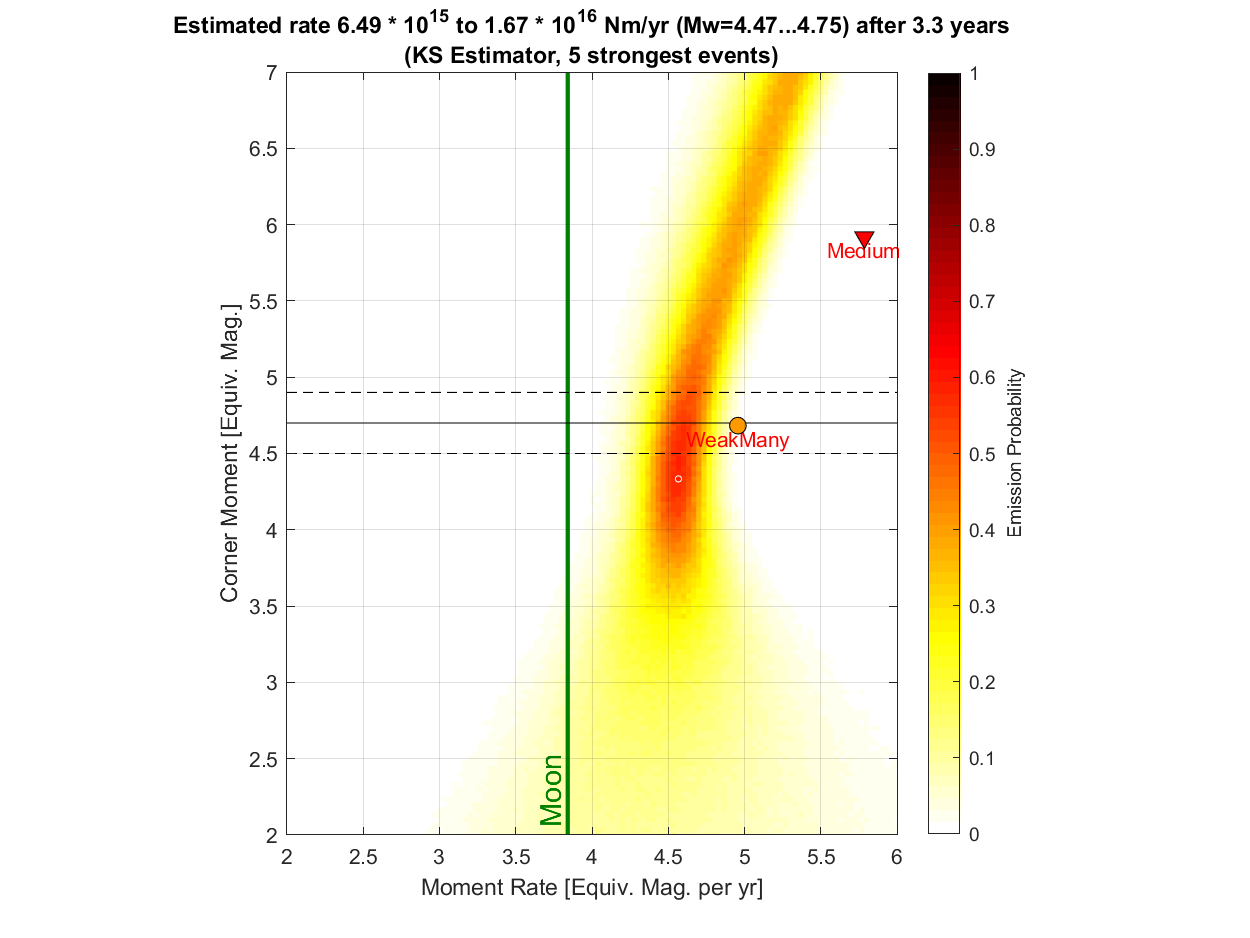Seismic Moment Rate of Mars after Event S1222a
- 1DLR Institut für Planetenforschung, Berlin, Germany (martin.knapmeyer@dlr.de)
- 2Institute of Geophysics, ETH Zürich, Zürich, Switzerland
- 3Department of Electrical and Electronic Engineering, Imperial College London, United Kingdom
- 4Swiss Seismological Service (SED), ETH Zürich, Zürich, Switzerland
- 5School of Earth Sciences, University of Bristol, United Kingdom
- 6Institut de physique du globe de Paris, Université de Paris, Paris, France
- 7NASA Marshall Space Flight Center, Huntsville, Alabama, USA
- 8Jet Propulsion Laboratory, California Institute of Technology, Pasadena, California, USA
On the 1222nd sol of the InSight mission (or May the Fourth of 2022), a seismic event was detected that turned out to be the largest marsquake recorded so far. At a moment magnitude of 4.7, event S1222a released as much seismic moment as all seismic events previously catalogued by InSight together, and greatly surpasses the second largest event, S0976a.
The frequency of occurrence of earthquakes follows a power law with an exponent (the b value) close to 1 over a wide range of magnitudes. The class of Low Frequency marsquakes, to which S1222a belongs, shows a similar behaviour. At low magnitudes, the slope of the cumulative distribution suggests that the InSight marsquake catalog for Low Frequency events is representative for events with moment magnitude exceeding 3 (Figure 1). Up to and including the occurrence of event S0976a one could however guess that events larger than magnitude approx. 3.6 might be less frequent than predicted by this power law. Event S1222a mends this apparent decrease, and the b value derived from all events is 1 within the formal uncertainty. Hence the resulting distribution follows a power law for events exceeding magnitude 3.

Figure 1 Size frequency distribution of Low Frequency and Broadband events. Red: status before occurrence of S1222a, blue: afterwards. The dashed lines represent the Maximum Likelihood solutions for fitting a Power Law distribution, with b-values as indicated in the legend.
Since S0976a occurred at an epicentral distance of about 140° (Horleston et al., 2022) at night time(02:26 LMST), but was recorded with amplitudes high enough to be visible during typical day time noise, we can infer that the catalog is complete for events the size of S0976a or larger. Since the slope of the distribution appears to be stable over the entire magnitude range from 3 up to that of S1222a, we conclude that the catalogue of Low Frequency events is not only representative, but complete for events larger than 3.
The magnitude of S1222a is slightly to the right of the value predicted by the power law, but, compared to other deviations, not excessively so. Also, the distribution does not show an indication of increasing slope any more. With about 30 events of magnitude 3 during the 3.3 years of InSight observations so far, this suggests that events larger than S1222a can be expected with respective recurrence rates: A magnitude 5 event appears likely about once in 11 years, i.e. on a decadal scale.
We use the approach of Knapmeyer et al. (2018) to estimate the seismic moment rate of Mars, and also the corner magnitude above which the size-frequency distribution becomes much steeper and events larger than the corner magnitude extremely unlikely (our analysis uses the Tapered Gutenberg-Richter distribution with an exponential roll-off above the corner frequency). The simple idea of Knapmeyer et al. (2018) was that, since a few large events release most of the seismic moment, the moment of the largest event ever observed, scaled with the duration covered by the catalog and a factor depending on b value and corner moment, provides a good estimation of the moment rate. Including not only the one largest, but the n largest events (with n between 1 and 10 or so) provides an even better estimation. In the 2018 study we have shown that the approach yields a surprisingly good estimation of the Earth's moment rate after a few months of registration, rather than after the many decades necessary to witness a magnitude 9 event.
We employ here an estimation based on the 5 largest events in the catalog. Knapmeyer et al. (2018) have shown that this low number may already provide a reasonable rate estimate. At the same time we attempt to avoid using events too small to be globally detectable. Future analyses will show if the use of 5 events is actually the best choice. The inclusion of event S1222a shifts the estimated moment rate slightly upwards, as well as the estimated corner moment. Figure 2 shows that both parameters are slightly below those of the WeakMany model of Knapmeyer et al., (2006). Compared to the catalog from before its occurrence, the parameter modifications due to S1222a are hardly significant (and not shown here). At least as important is the reduction of the uncertainty region in the moment-rate / corner-moment parameter space. We cannot yet exclude that the moment rate of Mars is as low as that of the Moon, but if it were, it would be rather unlikely to observe the event sequence that InSight observed.

Figure 2 Estimation of Moment Rate and Corner Moment. For each Pixel, 10000 synthetic catalogs were evaluated to compare their parameters with the five largest events from the InSight catalog (KS5 estimation). Colour indicates the probability that the five largest events drawn from a tapered Gutenberg Richter distribution in 3.3 years reproduce the KS5 estimation obtained from the observed events, to within an 80 % interdecile around the median. The vertical line indicates the moment rate for the Moon (observed, from Shallow Moonquakes), markers indicate the WeakMany and Medium models of Knapmeyer et al. (2006). The moment rate of the Earth corresponds to an equivalent magnitude of about 8.5 (Knapmeyer et al., 2018). Horizontal lines indicate the magnitude of the largest event and its uncertainty. The maximum of the distribution is marked by a small white circle.
References
Horleston, A. C., et al. (2022). The Far Side of Mars: Two Distant Marsquakes Detected by InSight, The Seismic Record. 2(2), 88–99, doi: 10.1785/0320220007
Knapmeyer, M., Oberst, J., Hauber, E., Wählisch, M., Deuchler, C., Wagner, R. (2006). Working models for spatial distribution and level of Mars' seismicity. Journal of Geophysical Research, vol. 111, E11006, doi:10.1029/2006JE002708
Knapmeyer, M., et al. (2018). Estimation of the Seismic Moment Rate from an Incomplete Seismicity Catalog, in the Context of the InSight Mission to Mars, Bull. Seis. Soc. Am., vol. 109, No. 3, 1125-1147, doi: 10.1785/0120180258
Taylor et al., (2013). Estimates of seismic activity on the Cerberus Fossae region of Mars, Journal of Geophysical Research, vol. 118, 2570-2581, doi:10.1002/2013JE004469
How to cite: Knapmeyer, M., Ceylan, S., Charalambous, C., Clinton, J., Dahmen, N., Duran, C., Horleston, A., Kawamura, T., Kim, D., Plasman, M., Stähler, S., Zenhäusern, G., Weber, R. C., Giardini, D., Panning, M., Lognonné, P., and Banerdt, B.: Seismic Moment Rate of Mars after Event S1222a, Europlanet Science Congress 2022, Granada, Spain, 18–23 Sep 2022, EPSC2022-845, https://doi.org/10.5194/epsc2022-845, 2022.

